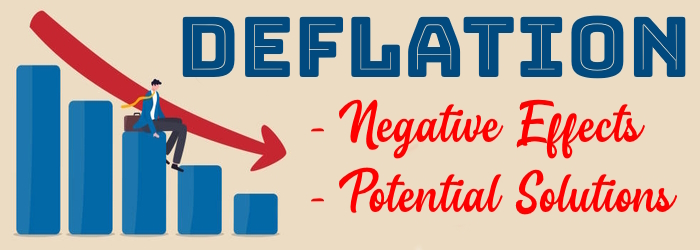Mitigating Deflation: Potential Solutions for Addressing a Complex Economic Phenomenon
Deflation can be a challenging economic phenomenon to address, as its causes can be complex and multifaceted. However, there are several solutions that policymakers can consider to mitigate the negative effects of deflation and promote economic growth. Here are some potential solutions for deflation:

Table of Contents
Negative Effects of Deflation and Potential Solution
Monetary Policy
One of the primary tools used by central banks to combat deflation is monetary policy. Central banks can use various measures, such as lowering interest rates, increasing the money supply, and purchasing assets, to stimulate economic activity and increase inflation. By reducing borrowing costs and making it easier for businesses and consumers to access credit, central banks can encourage spending and investment, thereby stimulating economic growth.
Fiscal Policy
Fiscal policy can also be used to address deflation. Governments can implement measures such as tax cuts, increased public spending, and infrastructure projects to boost economic activity and create jobs. These measures can increase demand for goods and services, which can help to offset the negative effects of deflation.
Structural Reforms
Structural reforms can help to address some of the underlying causes of deflation, such as weak productivity growth and labor market rigidities. Governments can implement measures to increase competition, reduce regulatory burdens, and promote innovation, which can help to boost productivity and promote long-term economic growth.
Currency Depreciation
A weaker currency can help to stimulate demand for exports and increase inflation. Governments can allow their currencies to depreciate relative to other currencies, which can make exports cheaper and more competitive in international markets. This can increase demand for domestically produced goods and services, which can help to stimulate economic activity and promote growth.
Price Level Targeting
Price level targeting is a monetary policy approach that aims to stabilize the overall price level in an economy. Under this approach, central banks would target a specific price level and adjust monetary policy accordingly to ensure that inflation remains within a predetermined range. This can help to prevent deflationary spirals and promote economic stability.
Direct Cash Transfers
Direct cash transfers to individuals can help to boost consumer spending and increase demand for goods and services. Governments can provide stimulus payments or tax rebates to individuals, which can encourage spending and investment, thereby stimulating economic growth.
Debt Restructuring
In a deflationary environment, high levels of debt can become particularly problematic, as the value of the debt increases relative to the overall price level. Governments can implement debt restructuring programs to help households and businesses manage their debts and avoid defaults. This can help to stabilize the financial system and prevent economic contraction.
Investment Incentives
Governments can implement investment incentives, such as tax breaks or subsidies, to encourage businesses to invest in capital equipment, research and development, and other activities that can help to boost productivity and promote long-term economic growth.
Labor Market Reforms
Labor market rigidities, such as minimum wage laws and labor union protections, can contribute to deflationary pressures by increasing labor costs and reducing flexibility. Governments can implement labor market reforms, such as reducing the minimum wage or making it easier for businesses to hire and fire workers, to increase labor market flexibility and encourage job creation.
International Cooperation
Deflation can be a global phenomenon, and international cooperation can be essential in addressing its underlying causes and promoting economic growth. Governments can work together to coordinate monetary and fiscal policies, promote trade and investment, and implement structural reforms that can help to boost productivity and stimulate economic activity across borders.
Conclusion
Deflation can be a challenging economic phenomenon to address, but policymakers have a range of tools at their disposal to mitigate its negative effects and promote economic growth. By implementing a combination of monetary, fiscal, and structural reforms, governments can work to ensure that their economies remain stable and prosperous in the face of deflationary pressures.



